Auditing the Kanban
Overview
Once the kanban has started, the next task becomes keeping it going and reducing the kanban quantities . The task of keeping the kanban going centers on the process of auditing and making corrections as problems are discovered . This chapter addresses the auditing function and proposes a process for implementing corrective action. Chapter 9 will address how to reduce the kanban quantities by implementing the continuous improvement techniques of Single Minute Exchange of Dies (SMED), Total Productive Maintenance (TPM), Preventative Maintenance (PM), 5s, scrap reduction, and buffer reduction. Our kanban process flow now expands to include auditing of the kanban, as shown in Figure 8-1.
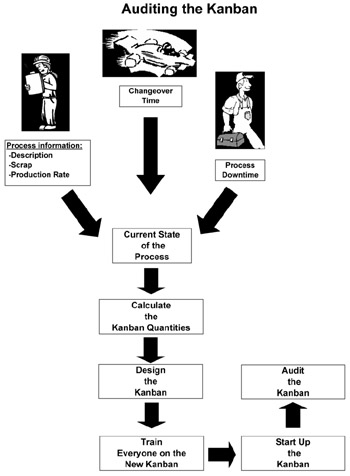
Figure 8-1: Expanded Kanban Process Flow.
By auditing of the kanban we mean verifying the kanban runs as designed. The plant material managers or schedulers usually perform this task.
The audit process consists of cycle counting and reviewing past production records. The cycle count will provide an up-to-the-minute inventory that can be compared to the signals to make sure they match. The review of production records will confirm that the production operators are following the kanban signals. When auditors find a problem, they must implement the necessary changes or seek help to get the kanban back on track. When the correction is not obvious, problem solving will be required to identify and correct the problem.
The auditing function also includes making sure the kanban size is adequate to support any production requirement changes. To determine whether the kanban size supports production requirements, compare the current production requirement's forecast to the base-line quantities used to size the kanban. If the requirements have changed by 15 to 20 percent, then consider resizing the kanban.
Although auditing seems like a mundane task, most kanbans fail because no one initiated this function or let it slide over time. As a result, the kanban's problems never get corrected and production requirement changes never get addressed. Consequently, the kanbans become useless and the plant returns to its original forecast, or push, schedules. Figure 8-2 shows the relationship between auditing and assessing requirements to maintaining the kanban.
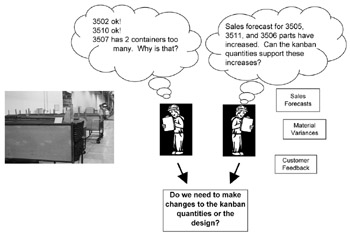
Figure 8-2: Auditing and Assessing Requirements are Key to Maintaining the Kanban.
Formalizing the Audit Process
The first step to the audit process is to set up a regular schedule for conducting the audits . We recommend making this a daily procedure initially, and later reducing it to once or twice per week. The purpose of the audit is to get the kanban running and then keeping it running.
Use the audits to force the operators to run their kanban. Also, don't let the auditor become their mom or dad!
When auditing the kanban, look for the following items:
- Have any of the scheduling signals or pieces disappeared?
- Is the inventory correct (containers versus signals)?
- Are the operators, material handlers, and customers following the design?
- Does anyone in the process have any questions or concerns?
- Do the original sizing assumptions and calculations still apply?
To determine whether any of these situations exist, the auditor must go to the kanban. With the exception of checking requirements versus the design, the audits cannot be conducted from the office.
We recommend that you also create standard forms to track the inventory and to track kanban compliance over time. Figures 8-3 and 8-4 show forms that perform these functions.
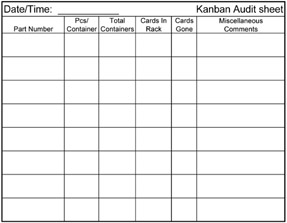
Figure 8-3: Audit Form.
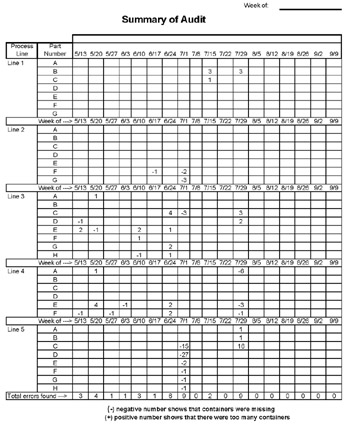
Figure 8-4: Completed Audit Summary Form.
The audit will take the physical form of:
- Conducting a cycle count
- Counting the signals
- Talking to the operators, material handlers, customers and their supervisors
- Checking the kanban design and size versus the long- term requirements
As you collect the data, compare answers to the above questions to determine:
- Whether a problem exists
- What the possible solutions are
Finding the Problem
How will you detect these changes? The audits or your analysis of future requirements will uncover the issues. In terms of the audit, you will begin to see the kanban material stops flowing , the production flow will begin to jump around instead of roughly following the preferred sequence, or stock-outs become a regular occurrence.
If you find a problem, then begin your investigation into the cause. Don't consider failures in process discipline as failures in kanban scheduling. Do not stop kanban scheduling just because you find a problem ”let the kanban keep operating while you figure out how the problem occurred.
When you find the problem, asks yourself and all the involved participants : What has changed? Also apply the 5 Whys and 1 How (or 5W1H) approach to determine the cause of the problem. When using 5W1H, ask why until you get to a root cause, then ask how this cause could have happened . As Figure 8-5 illustrates, the auditor needs to put the pieces of the jigsaw puzzle together to understand how the problem occurred.
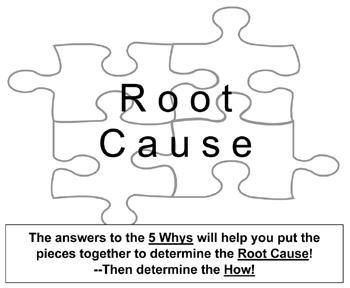
Figure 8-5: Problem Solving to Keep The Kanban Operating Properly.
Once you know the answers to these questions, make the appropriate corrections. Even if the change is simple, make sure that you communicate and coordinate the change with all affected parties. (Don't forget the first rule of communication ”you can't over-communicate.)
When you begin to see problems occur, also go back to the original kanban sizing calculations. Review the assumptions and, if necessary, recalculate the kanban quantities using the changes. Once you have the new figures, coordinate these changes and implement the new quantities .
Assess the Impact of Changing Requirements on the Kanban
When the kanban assumptions change significantly, the kanban quantities must also change (or be resized) up or down. The direction of the change will depend on production requirement or demand changes. Note that these changes can be due to more than just changes in demand. Changes can occur when:
- Changes in process operating parameters (scrap, downtime, or changeovers) are causing capacity increases or decreases
- Lack of process control is forcing an increase in buffer inventory
Additionally, when changes (other than production requirements) force you to make increases in the kanban quantity, target these problems as a continuous improvement opportunity. Make sure that everyone understands why the kanban quantities increased and task them to develop an improvement action plan.
Another consideration is that you must keep track of cyclical demand for your products. For example, do you sell much lawn furniture in December? Or, when do you sell more barbecue sauce, in December or July? If you have cyclical demand, then you will need to plan on the periodic recalculation of the kanban quantities to address these changes. When looking at cyclical demand, also consider the leveling of production to meet peak demand or developing alternate production items with opposite cyclical demand (for example, producing lawnmowers and snow blowers).
As you audit the kanbans, keep track of the number of times you must resize due to changes. If you are resizing the kanban more than three to four times per year, then go back to your original design and reassess it for sensitivity to the changing parameters of your business. You may need to change your buffer quantities to support production fluctuations. These types of assessments will come with experience. Just remember that you are implementing the kanban to improve production management and improve flow, not to complicate your operation.
Using the Workbook
The CD-ROM Workbook contains the audit form and the audit summary form for your use in setting up a formal audit process. The Workbook also has questions to guide you through the process of creating an audit plan.
Summary
Once you launch your kanban, it is time to create a process for auditing the kanban. Your goal must be to get the kanban started and to keep it running: Auditing will be the key to keeping it running.
The first step is to set an audit schedule. Initially, audit daily; then move to one or two times per week.
When you audit, you need to look for the following items:
- Have any of the scheduling signals or pieces disappeared?
- Is the inventory correct (containers versus signals)?
- Are the operators, material handlers, and customers following the design?
- Does anyone in the process have any questions or concerns?
- Do the original sizing assumptions and calculations still apply?
As you find problems, then use the 5 Whys and 1 How (or 5W1H) method to determine the root cause and to determine how the problem occurred. Once you know how the problem occurs, then make the necessary corrections.
Also, reassess the appropriateness of the kanban size and make corrections as appropriate.
Preface
- Introduction to Kanban
- Forming Your Kanban Team
- Conduct Data Collection
- Size the Kanban
- Developing a Kanban Design
- Training
- Initial Startup and Common Pitfalls
- Auditing the Kanban
- Improving the Kanban
- Conclusion
- Appendix A MRP vs. Kanban
- Appendix B Kanban Supermarkets
- Appendix C Two-Bin Kanban Systems
- Appendix D Organizational Changes Required for Kanban
- Appendix E EOQ vs. Kanban
- Appendix F Implementation in Large Plants
- Appendix G Intra-Cell Kanban
- Appendix H Case Study 1: Motor Plant Casting Kanban
- Appendix I Case Study 2: Rubber Extrusion Plant
- Appendix J Abbreviations and Acronyms
EAN: 2147483647
Pages: 142
